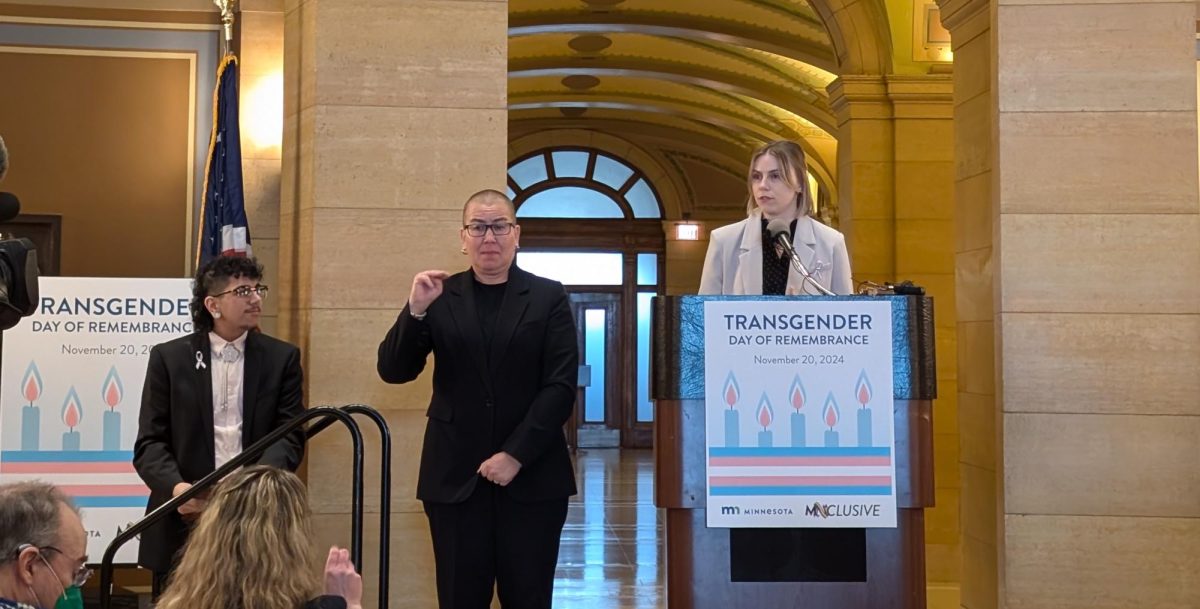After Minneapolis police officer Mark Hanneman killed Amir Locke Feb. 2, the Attorney General’s Office and Hennepin County Attorney’s Office released a report on the event, including why Hanneman was not criminally charged. The report also includes firsthand accounts from officers and witnesses.
The report was published on April 6, the same day Attorney General Keith Ellison and Hennepin County Attorney Mike Freeman announced that Minneapolis Police Department (MPD) officer Mark Hanneman would not face criminal charges for killing Locke.
On Feb. 2, just before 7 a.m., Hanneman shot and killed Locke at Bolero Flats apartments in Minneapolis. Officers entered the apartment using a no-knock warrant, meaning that they did not have to announce their presence before crossing the threshold. Hanneman shot and killed Locke less than 10 seconds after police entered the apartment.
Hanneman was put on paid administrative leave until Feb. 28 and is now back on duty, but no longer serves on SWAT, according to the Star Tribune.
Since Hanneman killed Locke, activists have pushed for a ban on no-knock warrants. On April 8, Mayor Jacob Frey put limits on no-knock warrants in Minneapolis.
The joint report details background information, pre-warrant briefing and planning, the execution of the warrant and MPD policies and procedures. It also explains why Hanneman was not charged with homicide. The report uses findings from the investigation into Locke’s killing by the Minnesota Bureau of Criminal Apprehension (BCA), the AGO and the Hennepin County Attorney’s Office.
Background information and pre warrant planning
On Jan. 10, St. Paul police began investigating a homicide involving a fire weapon. The investigators linked suspects to Bolero Flats apartments in Minneapolis.
St. Paul police obtained a knock-and-announce warrant for apartment 701 where Locke was staying. A knock-and-announce warrant means that officers must knock loudly and declare their presence before entering the threshold. Tatyana Henderson was living at apartment 701 with Marlon Speed, a suspect named on the warrant.
After obtaining the warrants, St. Paul investigators reached out to MPD Sgt. John Sysaath to request assistance from MPD SWAT teams to execute the warrants. After consulting with MPD SWAT Lt. Thomas Campbell, Sysaath told St. Paul investigators that MPD SWAT would only assist with no-knock warrants.
Execution of the warrants
The joint report includes first-hand accounts from people who were present at the apartment, which includes officers and two residents. Interviews with Henderson and Speed were conducted by the BCA during their investigation into the homicide.
Henderson said she was sleeping in the bedroom with Speed when the officers entered the apartment. She said she was confused and thought people were breaking in. Speed said he woke up when the police entered. He said he then heard gunshots and then the police announce themselves, in that order.
Speed and Henderson were found in the bedroom of the apartment during the execution of the warrant.
Sysaath was the first officer to enter the apartment and can be heard yelling “Police,” in body camera footage. Sysaath submitted a written statement for the joint report that said he saw Locke when he entered the apartment.
When Locke sat up, Sysaath said he noticed a tan colored firearm in his hands pointed in the direction of Hanneman, who was standing about three feet in front of the gun. Sysaath said he believed Locke was going to shoot at Hanneman or the officers, according to the report.
Hanneman also submitted a written statement. He wrote he was the third officer to enter apartment 701 and once inside, he saw a blanket rising and falling from the couch in the apartment, which he indicated meant a person was on the couch.
As Hanneman moved to the couch, he wrote that another SWAT officer kicked the couch. Hanneman then saw Locke begin to rise with a handgun that he said was pointed at him.
“I was convinced that the individual was going to fire their handgun and that I would suffer great bodily harm or death,” Hanneman wrote in his statement. “I felt in this moment that if I did not use deadly force myself, I would likely be killed. There was no opportunity for me to reposition myself or retreat. There was no way for me to de-escalate this situation.”
Hanneman wrote that he fired his gun three times at Locke, then jumped on his back to restrain Locke.
The footage on Hanneman’s body camera cuts off shortly after Hanneman was on top of Locke, and Hanneman said he believes the camera deactivated at some point during the struggle. After Hanneman shot and killed Locke, another officer escorted Hanneman out of the apartment, according to the report.
MPD Policies
MPD policies allow for use of force when necessary which aligns with the Minnesota state statute for use of deadly force. The policy states that deadly force can be used only when lives are at risk and other tactics for de-escalation have been considered and would be unsuccessful.
David Schultz is a law professor at the University of Minnesota. Schultz said it would be difficult to overcome the burden of proof for a homicide charge in this case because of the rules surrounding use of deadly force.
“I think what the Attorney General and Freeman were thinking was on one level it doesn’t matter if the person was a suspect,” Schultz said. “An officer at that point had no idea whether or not Locke was going to pull the gun out on them, or whether he was perhaps a potential co-conspirator or co-defendant. All this would be difficult for the prosecution to be able to make their case.”
Since then, various Minneapolis public officials and activists started calling for an end to no-knock warrants. On April 8, Minneapolis mayor, Jacob Frey, enacted a new policy that prohibits the use of no-knock warrants, except for in exigent circumstances.
Abigail Cerra was the Chair of the Police Conduct Oversight Commission in Minneapolis, but recently resigned from her position. Cerra said Locke’s death highlights the danger of no-knock warrants for civilians and officers.
“If somebody had firearms and was known to use them to commit murder and harm people, charging in on somebody unannounced in the middle of a night when everyone’s asleep just presents a risk all the way around,” Cerra said.














Meat Eater
Apr 29, 2022 at 2:34 pm
If your neighborhood is so dangerous you need to sleep with a gun under the covers, don’t blame the police, blame the neighborhood.